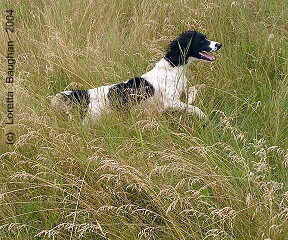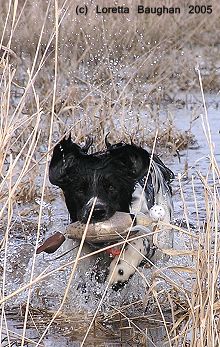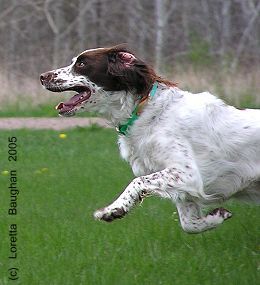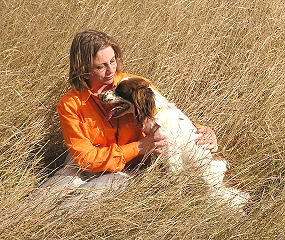

It wasnít long ago that capturing breath taking photographs of spaniels in action was primarily the domain of the professional photographer, dedicated shutterbugs - and occasionally, the lucky novice. However, like with so many of our modern conveniences weíve integrated into our daily lives - cell phones, computers and satellite television programming to name a few - photography has likewise evolved. In recent years, digital photography equipment has bounded light years beyond what most photographers could have only fantasized a decade ago. As a working professional photographer, I, along with many of my colleagues scoffed at the thought that
film photography would ever be replaced by anything else. Quality photography with no film? How absurd! Exploring the capabilities of todayís cutting edge photography equipment leaves a photographer feeling like Buck Rogers in the 21st Century... OK... I guess it IS the 21st century, isnít it? With the incredible advancements achieved in digital camera equipment, ease of operation plus considering the affordability factor, now just about anyone can shoot great photos of their spaniel. So, what are you waiting for?
For those who have not yet took the plunge and bought a digital camera, perhaps the best piece of advice I can offer is to purchase one with rechargeable batteries. If you have an older model that doesnít use rechargeable batteries, give it away - and replace it with one that does. You will thank me as you quickly recoup the price of that new camera in the amount of money you would have spent on batteries for the old one.
On to the fun stuff... getting that photo of your spaniel in action!
Most simple digital cameras will have a setting for "action" photos. On my Olympus Camedia, it is indicated on the selection dial as a stick figure in a running pose. Very simple. Set the dial and youíre good to go.
Panning and Anticipating Your Subject
Take the dog for a run in a field and shoot some practice photos so you can become comfortable with the technique and operation of your camera. As you walk along, pan the camera, trying to keep the image of your dog in the view screen. I find it is easier if you have the strap around your neck and are looking at the screen on the camera back rather than through the viewfinder. When you click the shutter, there is a delay before the photo is actually taken, due to the cameraís auto focus. This takes a little bit of getting used to. Although slightly overcast skies result in the nicest even lighting conditions, shooting photos on a bright day will help to reduce the length of delay. Also, the focusing delay is greater when using the telephoto lens as opposed to a wide angle shot. If necessary, choose a medium length setting for your lens. Thatís ok.
If you get a really good shot, it can be cropped in the computer to become a fantastic photo.
The second technique to master is the ability to anticipate what your dog will do next. It's not as difficult as it may seem at first. This is an exercise in keen observation. If you participate in field trials, hunt tests or hunt your dog, you should be familiar with reading your dogís body language. Itís just knowing when your dog is indicating game. Start with quartering the dog in front of you and taking some side view running shots. Also try whistling him in or tossing a dummy for him to retrieve.
One of the great things about digital cameras is the instant gratification of seeing your photo seconds after shooting it. Take a couple of minutes to review the photos youíve shot and edit out the bloopers as you go. What a luxury to be able to pitch the duds - without having to pay the photo lab to process the film!
"Put a camera in the hands of a six-foot tall man and invariably, youíll see a photo of a spaniel that looks like a pickle with feet."
Point of View
Many of us from the pre-digital, pre-computerized, pre-MTV generation grew up with instamatic, pocket or polaroid cameras. These point and shoot gems opened the Pepsi generationís eyes to the thrill of photography. The point and shoot aspect of todayís digital cameras are a reawakening call to those who may have lost that loving feeling for the hobby over the years. A digital camera puts the ability to capture exciting photos within most anyoneís grasp. So why, you ask, do my photos still look like something Aunt Edna took before her cataract surgery? The problem can likely be traced back to 9th grade art class when you may have been more interested in passing notes to Susie, hitting the teacher in the back of the head with spitballs - or smokiní in the boysí room.
Itís a matter of perspective. If you fish, you probably are aware that trophy photos are always shot with the proud fisherman holding the catch of the day with his arm stretched out towards the camera, splashing fish slime all over the lens. Even a minnow will look like a whopper using this technique. Well, the same is true when taking a photo of your dog - except that the results arenít very flattering to your dog. Put a camera in the hands of a six-foot tall man and invariably, youíll see a photo of a spaniel that looks like a pickle with feet.
The solution? Get down to the level of your dog. Squat or even sit right on the ground. Of course, that may not always be practical. But one of the things I love about todayís digital cameras is the large view screen on the back of the camera. You can hold the camera down at waist level as you stand or walk, see that youíve got your subject in the frame and shoot to your heartís content. For me, thatís usually until the batteries die!
Try it... you may just be amazed at what a great photographer you can be!
Taking it to the Next Level
Do you dream of capturing the "perfect" photo of your spaniel running full-tilt, flushing a bird or making a dynamic water entry? Itís possible - and may be easier than you think.
The running shots are done using the panning technique and holding the camera low, as described above.
Most "picture perfect" dog flushing a bird shots are either a result of being in the right place at the right time and a lot of luck - or they are set up. Have someone plant a bird for you in a location where cover is minimal. Position yourself far enough away so as not to be a distraction to the dog, yet, where you can be prepared to get the shot. Pay attention to the lighting conditions. If it is a sunny day, have the sun directly behind you. Sit right down on the ground and signal your helper to handle the dog in to the bird.
Perhaps the easiest "action shot" to achieve is the dynamic water entry. Choose a water location where you can position yourself down the shoreline at a right angle to where the dog will enter the water. Have the handler send the dog in. Experiment with holding the camera stationary or panning it. Catch the dog in mid-air or splashdown. Try moving across the pond or small river to get a head on shot of the dog. The possibilities are limited only by your imagination. Most of all... have fun!
Fame
Now that you are inspired to take the camera along the next time you take the dog out, plan to send your best shot in to Spaniel Journalís third annual photography contest. This yearís theme is, of course, spaniels in action. The contest runs through June 20th with the winning entry to receive "fame" as the cover shot for our July-August issue along with a prize package that includes the Kirkham Gundogs Spaniel Training DVD set and an autographed copy of Pamela Kadlecís Retriever Training for Spaniels. Check the contest rules and submission details... and good luck!
|
|
| Bookstore | Bill Fawcett Reviews | Advertise on SJ | Classifieds | Resources | Events | Point Standings | Archives | In Memory | |
|
|
Copyright © Spaniel Journal & L Baughan Webdesign, 2002-2006, all rights reserved worldwide |
|



